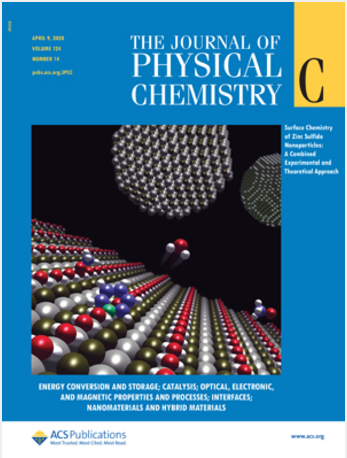Impact of Halide Substitution in the Inorganic Framework on the Optical Activity of Chiral Metal-Halide Perovskites
IF 3.3
3区 化学
Q2 CHEMISTRY, PHYSICAL
引用次数: 0
Abstract
The combination of chiroptical and semiconducting properties makes chiral hybrid metal-halide perovskites a promising class of materials for optoelectronic and optospintronic devices. Still, the detailed connection between the material composition and optical activity remains to be fully understood. Here, we study the effect of halogen substitution on optical activity in the chiral hybrid perovskite (R,S,rac)-3BrMBA2PbI4(1–x)Br4x. We find that an unusual sign-flip occurs in the circular dichroism (CD) spectrum as the optical gap blue-shifts with increasing bromide content. We explain this observation by shifts in the energy level alignment caused by the halide substitution. We also observed an inverse relationship between the CD intensity and the microstrain induced in the lattice for mixed-halide compositions, which we attribute to inhomogeneity in chirality transfer across the inorganic framework. Last but not least, transient Faraday rotation measurements reveal that the (R/S)-3BrMBA2PbBr4 system exhibits a significant spin lifetime even at room temperature, underscoring its potential for spintronic applications.

无机骨架中卤化物取代对手性金属卤化物钙钛矿光学活性的影响
手性和半导体性质的结合使手性杂化金属卤化物钙钛矿成为光电子和光自旋电子器件的有前途的材料。尽管如此,材料成分与光学活性之间的详细联系仍有待充分了解。本文研究了卤素取代对手性杂化钙钛矿(R,S,rac)-3BrMBA2PbI4(1-x)Br4x的光学活性的影响。我们发现,随着溴化物含量的增加,光隙蓝移在圆二色(CD)光谱中发生不寻常的符号翻转。我们用卤化物取代引起的能级排列变化来解释这一观察结果。我们还观察到CD强度与混合卤化物组合物晶格中引起的微应变之间的反比关系,我们将其归因于无机框架中手性转移的不均匀性。最后但并非最不重要的是,瞬态法拉第旋转测量表明,(R/S)-3BrMBA2PbBr4体系即使在室温下也表现出显著的自旋寿命,强调了其自旋电子应用的潜力。
本文章由计算机程序翻译,如有差异,请以英文原文为准。
求助全文
约1分钟内获得全文
求助全文
来源期刊

The Journal of Physical Chemistry C
化学-材料科学:综合
CiteScore
6.50
自引率
8.10%
发文量
2047
审稿时长
1.8 months
期刊介绍:
The Journal of Physical Chemistry A/B/C is devoted to reporting new and original experimental and theoretical basic research of interest to physical chemists, biophysical chemists, and chemical physicists.
 求助内容:
求助内容: 应助结果提醒方式:
应助结果提醒方式:


